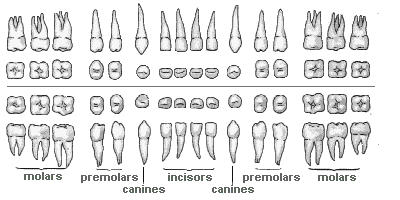
Permanent Teeth / Adult Teeth
Permanent teeth are the set of teeth that we get after the age of 6 years and serve us for the rest of our lives. We have 32 permanent teeth, 16 at each jaw, which are also known as secondary or adult teeth. They form the permanent dentition which is fully completed much later at the age of 17-21 years with the eruption of the third molars (wisdom teeth).
Development and formation of permanent teeth
The first human permanent teeth start to form even before birth as early as the last months of pregnancy. By the time of birth most of the permanent teeth can be found inside the human jaw in various stages of development, but they will only appear in the mouth several years later.
The process of permanent teeth formation is the same as in primary teeth. They start in the form of a tooth bud, an epithelial cells formation which later differentiates and creates the dental and periodontal tissues. The crown covered by enamel is the first part of the tooth to develop. Then the root begins to form, but it reaches full development about a year after the tooth has erupted.
Morphology and anatomy of permanent teeth
There are 32 permanent teeth, twelve more than the 20 primary teeth. The other main differences of adult teeth are:

- Larger size
- More yellowish color
- Thicker enamel
- More mineralized enamel and dentin
- Smaller pulp chambers
- Longer and bigger roots
- Premolars exist only in the permanent dentition
- They must last for a lifetime
Adult humans have 4 different types of teeth:
- 8 incisors
- 4 canines (cuspids)
- 8 premolars
- 12 molars
The tooth anatomy is the typical of human teeth. A chamber in the center of the tooth contains the soft living part of the tooth (dental pulp) which is surrounded by a hard layer of dentin. The outer surface of the tooth is covered by enamel in the crown area above the gums, and by cementum at the root area.
Eruption of permanent teeth
Around the age of 6-7 years the first adult teeth begin to erupt in the mouth starting with the first permanent molars, also known as 6 year molars. They erupt behind the second primary molars (which will later be replaced by the second permanent premolars). They are classified as non-succedaneous teeth because they do not replace any already existing teeth.
- Succedaneous teeth are the 20 permanent teeth including all incisors, canines, and premolars which replace their primary predecessors after they fall out. The pressure of the crown of the developing permanent tooth causes the resorption of the root of the primary tooth above it. Finally the baby tooth loosens and falls out, emptying the space for the erupting adult tooth.
- Non-succedaneous teeth are the 12 permanent molars, the 3 teeth at the back of each quarter of the mouth which fill the extra space in the larger adult jaw without replacing a pre-existing baby tooth.
The 6 year molars are considered as teeth with major importance for the further development of the dentition. Because of their strategic location they help the other permanent teeth come into their proper place. Unfortunately some parents are unable to distinguish them from the primary teeth next to them, and neglect their care believing that they will be fall out anyway. Due to this misinterpretation and their location further back in the mouth, the first permanent molars are very often decayed. If they become severely damaged and have to be extracted, the risk of developing a malocclusion (bad bite) increases significantly.
For the next 7 years the permanent teeth will erupt while the primary ones will fall out following the general pattern described in the following eruption chart of adult teeth:
Eruption Pattern/Chart of Permanent Teeth
| Permanent Teeth Chart | Eruption Time | |
| Upper Teeth | Lower Teeth | |
| Central Incisor | 7 to 8 yrs | 6 to 7 yrs |
| Lateral Incisor | 8 to 9 yrs | 7 to 8 yrs |
| Cuspid | 11- 12 yrs | 9 to 10 yrs |
| First Premolar | 10 to 11 yrs | 10 to 12 yrs |
| Second Premolar | 10 to 12 yrs | 11 to 12 yrs |
| First Molar | 6 to 7 yrs | 6 to 7 yrs |
| Second Molar | 12 to 13 yrs | 11 to 13 yrs |
| Third Molar | 17 to 21 yrs | 17 to 21 yrs |
From the eruption of the 6 year permanent molar until the age of 12 when the last primary second molars fall out, the child has in the mouth both primary and permanent teeth (mixed dentition).
Until the completion of 13th year the child will have 28 of the 32 permanent teeth, but the permanent dentition will be completed at the late teen years or early 20s with the eruption of the 4 last adult teeth, the 4 third molars or wisdom teeth.
The third molars are the last permanent teeth to erupt, and there may not be enough space left in the mouth for some or all of them. In this case they may erupt in a wrong position, or they may not erupt at all remaining trapped partially or fully inside the jaw, a condition known as impacted wisdom teeth. Often, they cause dental problems and have to be extracted by the dentist.

